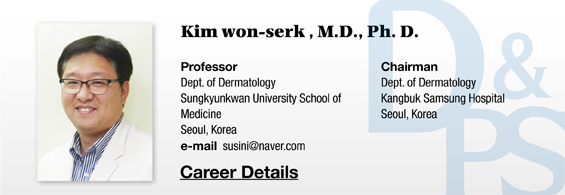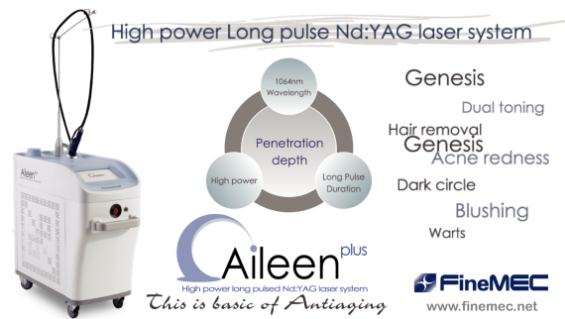Following the previous chapter, in this chapter, the treatments will be compared in more details.
Most of the current scar and keloid treatments are using several topical agents (silicone gel, contractubex, etc.) or intralesional steroid injection. Patients who are referred to my office have been treated by either one of them without exception, and they feel embarrassed when they learn about other options. These two common treatments are limited because topical agents are effective only in early or small lesions and because intralesional steroid injection is associated with systemic side effects or regional skin atrophy or vasodilation and high recurrence rate.
[Advertisement] ▶ Aileen plus(Long pulsed Nd:YAG Laser) – Manufacturer: FineMEC(www.finemec.net)
1. Cryotherapy
Cryotherapy has been suggested in literature as the most effective method to rapidly reduce scar volume. Among many uses of cryotherapy in dermatology, it is mostly used for eliminating tumor or verruca. The therapeutic principle is to inflict cold damage inside the cells to induce ischemia and damage of the blood vessels. This mechanism of action is well suited for the treatment of abnormal proliferation of fibroblasts and excessive collagen synthesis of a scar or keloid. Cryotherapy is particularly safe for children and pregnant women because it does not accompany a systemic side effect. Despite such apparent merits, cryotherapy is not commonly used on an outpatient basis because of the following reasons:
1) Inconvenience in maintaining the liquid nitrogen tank
2) Low patient satisfaction due to pain during the procedure and side effects, such as vesiculation, after the treatment
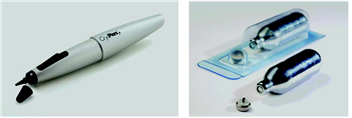
Figure 1. Commercialized small cryotherapy device. Refrigerant charge device is contained in the pen-type device.
Below are solutions for each problem:
Liquid nitrogen tank and cryotherapy device
In Korea, cryotherapy is most commonly used for clavus and verruca, which are covered by national health insurance, resulting in low medical fee. It is not very profitable for hospitals to prepare cryotherapy devices and facilities. Of course, it is not profitable either to prepare cryotherapy devices for a small number of scar and keloid patients. There are alternatives for liquid nitrogen device, however. One of the commonly used methods is to use easily obtainable dry ices prepared in various sizes in advance. Another method is to use a small cryotherapy device.
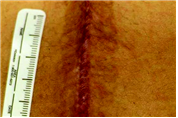
Figure 2. An example of a side effect of cryotherapy: excessive inflammation followed by pigmentation of the area surrounding the lesion due to the failure to confine the treatment to the lesion.
Side effects of cryotherapy
Side effects and discomforts arising from cryotherapy are not caused by cryotherapy itself but because cryotherapy is not well-standardized. Moreover, it is quite difficult to confine cryotherapy to the lesion compared to other devices because cryotherapy is used by simply spraying the liquid nitrogen to the lesion. It is important, therefore, to be well-informed about how to confine the treatment to the lesion, and how to modify the pressure when using a disc-type applicator, depending on the intended duration of exposure to liquid nitrogen. Latest devices such as those for monitoring temperature change on the skin or for elaborate cryotherapy as shown in Figure 1 are also available.
Figure 3 is a paper which introduced several tips for cryotherapy on narrow lesion (Dermatol Surg 2000; 26:493~494). One of the most recommended methods is to use disposable otoscope which are used in ENT clinics.

Figure 3. A paper introducing tips for cryotherapy.

Figure 4. Disposable otoscope is useful for elaborate cryotherapy on a narrow lesion.
2. Intralesional bleomycin injection
As mentioned in the previous chapter, 5-FU, bleomycin, verapamil and interferon are available as an alternate for steroids. Bleomycin, among others, is easily obtainable in an outpatient setting and is very effective. It is also more acceptable to doctors because it has been often used for the treatment of viral wart. I have personally learned that steroid and bleomycin injected in turns induced better effect, with less side effects compare with steroid monotherapy, however bleomycin cannot be free from side effects, such as pigmentation, injection site pain, and ulcer when excessive amount was injected. Reports suggested that side effects could be reduced by making multiple punctures on the lesion before applying bleomycin. Bleomycin and microneedle combination could be a promising.
3. Imiquimod (Aldara) application
Surgical procedure is still the most important and fast of scar or keloid. It is also true, however, that a lot of cases reccur or exacerbate even after achieving clinical improvement after surgery.
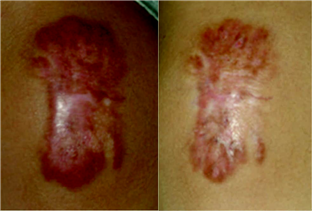
Figure 5. Keloid improved by the combination of bleomycin and needling
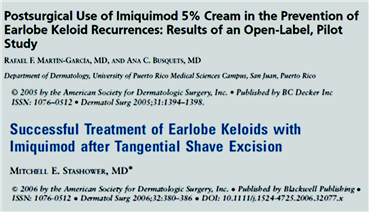
Figure 6. Reference paper
There are still controversies about imiquimod cream, but reports have suggested that recurrence has been prevented when it was applied after surgical removal of various scars. Considering the effect of imiquimod on various kinds of skin cytokines, such outcome seems probable enough. Lack of any specific side effect and discomfort in use are also the reasons why it deserves more studies in the future. Figure 6 shows papers worth reading.
- To be continued -
▶ Previous Artlcle : #3. Drugs and Topical Agents for Hypertrophic Scar and Keloid Treatment I
▶ Next Artlcle : #5. Laser for Scar Treatment Ⅰ













